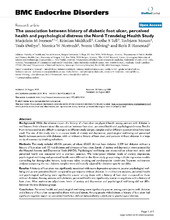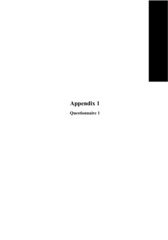| dc.contributor.author | Iversen, Marjolein Memelink | en_US |
| dc.date.accessioned | 2010-03-09T10:18:08Z | |
| dc.date.available | 2010-03-09T10:18:08Z | |
| dc.date.issued | 2010-02-05 | eng |
| dc.identifier.isbn | 978-82-308-0957-0 (print version) | en_US |
| dc.identifier.uri | https://hdl.handle.net/1956/3839 | |
| dc.description.abstract | The prevalence of type 2 diabetes is increasing dramatically and type 1 diabetes moderately both in Norway and globally. As a result, long-term diabetes-related complications are also likely to increase. One long-term complication of diabetes is diabetes-related foot ulcers, which represent challenges for the individual and for the health care system. Awareness is growing that more attention should be given to this condition. Aim: The main aim of this study was to obtain more knowledge about people with diabetes reporting a history of foot ulcer (HFU) in a large, unselected population sample in Norway. We wanted 1) to determine the proportion of self-reported foot ulcers that required more than 3 weeks to heal and investigate associated factors, 2) to examine preventive foot care practices for people with diabetes and identify factors associated with such ulcers, 3) to compare levels of anxiety and depression as well as psychological well-being and perceived health between people with diabetes with and without a history of foot ulcer and those who reported not having diabetes and 4) to estimate the mortality risk for people who reported a HFU, people with diabetes without a HFU and people without diabetes. Methods: The study used a cross-sectional design in Papers I–III and a prospective design in Paper IV. During 1995 to 1997, the second health survey was conducted in Nord- Trøndelag County, Norway, the Nord-Trøndelag Health Study 2 (HUNT 2). Those who responded positively to the question, “Do you have or have you had diabetes?” were classified as having known diabetes (n = 1972) and were invited to participate in the diabetes substudy. Those responding affirmatively to the question “Have you had a foot ulcer that required more than 3 weeks to heal?” were classified as having a HFU (n = 155) and those responding negatively as having diabetes without a HFU (n= 1339). Some 63,632 participants reported not having diabetes. Measures of sociodemographic, lifestyle and clinical factors were available as well as perceived health and several aspects of psychological distress such as symptoms of anxiety, depression and psychological wellbeing. Participants with self-reported diabetes were well characterized with regard to their diabetes condition. All participants in HUNT 2 were followed for 10 years, with mortality as the end-point. Results: The overall proportion of people with diabetes reporting a HFU was 10.4% [95% confidence interval (CI) 8.8%–11.9%]. Significant correlates of a HFU were male gender [1.5 (1.03–2.2)], age older than 75 years [odds ratio (OR) 1.8, 95% CI (1.2–2.8)], taller than the median (men >175 cm, women >161cm) [1.9 (1.3–2.8)], using insulin [1.6 (1.1–2.4)], and the presence of macrovascular complications [1.8 (1.2–2.6)] (Paper I). Some 58.8% of people with diabetes without a HFU reported regular preventive foot care (Paper II). Almost 85% reported receiving regular clinical diabetes examinations, 31.7% reported regular foot inspection by health care personnel and 66.3% reported foot selfinspection. In addition, participants’ reports of inspections by health care provider and their own inspections were strongly correlated (P < 0.001). Independent variables associated with reporting preventive foot care included female gender, long duration of diabetes (>10 years), insulin use and membership in the Norwegian Diabetes Association. Those who reported macrovascular complications were less likely to report regular preventive diabetes foot care. In Paper III, we reported that anxiety and depression symptoms did not differ between those with diabetes reporting a HFU and those with diabetes without a HFU or those without diabetes. Among those with diabetes, perceived health was significantly worse among those reporting a HFU while psychological well-being did not differ. Perceived health and psychological well-being were significantly poorer among those with a HFU than among those without diabetes. Participants who reported a HFU had an increased mortality rate compared with both the subjects who did not report diabetes (hazard ratio 2.29, 95% CI 1.82–2.88) and those who did report diabetes but not a HFU (hazard ratio 1.41, 95% CI 1.09–1.82). The excess risk persisted after adjusting for comorbidity and depression scores (Paper IV). Conclusions: Overall, among community-dwelling people with known diabetes, 1 out of 10 reported a HFU. Characteristics associated with a HFU were male gender, age older than 75 years, taller than the median for each sex, insulin use and the presence of macrovascular complications. The clinical picture among people with diabetes reporting a HFU was complex, with several complications appearing at the same time. A HFU was associated with poorer perceived health. However, among people with diabetes a HFU was not associated with more anxiety or depression symptoms or poorer psychological well-being. Reported regular preventive foot care practices were associated with female gender, insulin use and having had diabetes for more than 10 years. Those reporting macrovascular complications were less likely to report regular preventive diabetes foot care. The findings in this study reinforce previous evidence of a link between diabetic foot ulceration and increased risk of death and extend knowledge concerning excess mortality beyond what was previously known about people with foot ulcers attending specialist health care clinics. The excess mortality risk of approximately 40% was only partly explained by older age, sex (male), a higher percentage of glycosylated hemoglobin (HbA1c), current smoking, insulin use, microalbuminuria, cardiovascular disease and depression. Our findings indicate the importance of identifying and monitoring people with foot ulcers at an early stage. The findings suggest that systematically implementing evidence-based guidelines in diabetes care and foot care may be very important for those with a HFU, who are particularly susceptible to adverse outcomes. | en_US |
| dc.language.iso | eng | eng |
| dc.publisher | The University of Bergen | eng |
| dc.relation.haspart | Paper I: Scandinavian Journal of Public Health 36(1), Iversen, M. M.; Midthjell, K.; Østbye, T.; Tell, G. S.; Clipp, E.; Sloane, R.; Nortvedt, M. W.; Uhlving, S.; Hanestad, B. R., History of and factors associated with diabetic foot ulcers in Norway: the Nord-Trøndelag Health Study, pp. 62–68. Copyright 2008 the Nordic Societies of Public Health. Published by Sage Publications. Full text not available in BORA due to publisher restrictions. The published version is available at: <a href="http://dx.doi.org/10.1177/1403494807085314" target="_blank">http://dx.doi.org/10.1177/1403494807085314</a> | en_US |
| dc.relation.haspart | Paper II: Research in Nursing & Health 31(3), Iversen, M. M:, Østbye, T.; Clipp, E.; Midthjell, K.; Uhlving, S.; Graue, M.; Hanestad, B. R., Regularity of preventive foot care in persons with diabetes: results from the Nord-Trøndelag Health Survey, pp. 226–237. Copyright 2008 Wiley Periodicals, Inc. Full text not available in BORA due to publisher restrictions. The published version is available at: <a href= "http://dx.doi.org/10.1002/nur.20255" target="_blank">http://dx.doi.org/10.1002/nur.20255</a> | en_US |
| dc.relation.haspart | Paper III: BMC Endocrine Disorders 9(18), Iversen, M. M.; Midthjell, K.; Tell, G. S.; Moum, T.; Østbye, T.; Nortvedt, M. W.; Uhlving, S.; Hanestad, B. R., The association between history of diabetic foot ulcer, perceived health and psychological distress: the Nord-Trøndelag Health Study. Copyright 2009 Iversen et al; licensee BioMed Central Ltd. Reproduced with permission. Published version. The published version is also available at: <a href="http://dx.doi.org/10.1186/1472-6823-9-18" target="_blank">http://dx.doi.org/10.1186/1472-6823-9-18</a> | en_US |
| dc.relation.haspart | Paper IV: Diabetes Care 32(12), Iversen, M. M.; Tell, G. S.; Riise, T.; Hanestad, B. R.; Østbye, T.; Graue, M.; Midthjell, K. A., History of Foot Ulcer Increases Mortality Among Individuals With Diabetes. Ten-year follow-up of the Nord-Trøndelag Health Study, Norway, pp. 2193–2199. Copyright 2009 by the American Diabetes Association. Full text not available in BORA due to publisher restrictions. The published version is available at: <a href="http://dx.doi.org/10.2337/dc09-0651" target="_blank"> http://dx.doi.org/10.2337/dc09-0651</a> | en_US |
| dc.title | An epidemiologic study of diabetes-related foot ulcers. Issues related to prevention and mortality based on the Nord-Trøndelag Health Study (HUNT 2) | en_US |
| dc.type | Doctoral thesis | |
| dc.rights.holder | Marjolein Memelink Iversen | |
| dc.subject.nsi | VDP::Medisinske Fag: 700::Klinisk medisinske fag: 750::Endokrinologi: 774 | nob |


